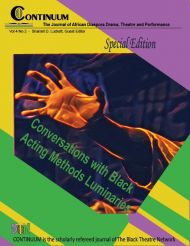Buckner, Jocelyn L., A Critical Companion to Lynn Nottage. Milton Park, Abingdon, Oxon; New York, NY: Routledge, 2016.
A Critical Companion to Lynn Nottage is a comprehensive assessment of the “unapologetically female-centered plays” (1) that comprise Lynn Nottage’s magnificently heterogeneous dramaturgical oeuvre. Given the appreciation Nottage’s work has garnered in academic and public arenas—among other well-deserved accolades, she has won two Pulitzer Prizes, a Guggenheim, and a MacArthur—it is extraordinary that no scholarly anthology of Nottage’s plays predates this 2016 publication. Thus, this volume edited by Jocelyn Buckner fills important lacunae and forges new ground.
Edifying and engaging, A Critical Companion to Lynn Nottage unites perspicacious analyses from well-established authorities and emerging scholars—some of whom are also dramaturgs, directors, and actors; all of whom possess superior critical acumen. Interrogating Nottage’s theorization of black identity, gender, and performativity, the essays offer nuanced investigations of the themes that Nottage tirelessly negotiates: gender and gendered relationships; race and questions of cultural heritage and class; representations of familial bonds; and the portrayal of socially and politically hierarchical relationships that are filtered through and around intersectional power dynamics.
Divisible in four parts, the volume begins with an introductory section consisting of three brief essays. Sandra Shannon’s insightful forward situates Nottage’s plays as works that hinge on metatheatrical and metaliterary examinations of identity, particularly regarding freedom and matrices of gendered relationships that prioritize the female voice and female selfhood. Dedicating the anthology to “expanding and complicating” evaluations of Nottage, Buckner’s concise yet substantive introduction underscores the various scholarly and social modalities—ethnography, history, gender studies, identitary explorations, aesthetics, and social justice, among others—from which Nottage draws. This range speaks to the distinctive complexity and depth of Nottage’s works and to the degree of reflection and engagement she intends to inspire. Providing an instrumental reference point for the rest of the collection is Scott Knowles’s chronological presentation of the production history of Nottage’s plays, her activism, and the trajectory of her career.
The second and largest section of the anthology includes six chapters on specific plays. After discussing Langston Hughes’s poem “Luck”—after which Crumbs from the Table of Joy is entitled—Jayne Austin Williams deftly considers the elusive nature of freedom with which Crumbs’ characters grapple while confronting hindrances such as “incapacitation,” “crippling,” and literal and metaphorical illnesses obligating them to defer their desires despite yearning for more liberatory options. Jennifer Hayes evaluates choral performance and the heuristic implications of polyvocality in Mud, River Stone. She parses Nottage’s incisive critique of the problematic way Africa is often conceptualized as either a denigrated, backwards land permanently scarred by colonialization, or as a land reified and fetishized by superficial applications too easily extended to the eroticized and harmfully treated body and presence of African and African Diasporic women.
After considerations of Renaissance Art and Diego Velázquez’s Las Meninas from which Nottage’s play takes its title, Buckner analyzes Nottage’s representation of diasporic desires. Emphasizing the displacement, erasure, and silencing of racialized and gendered bodies, Buckner offers a keen investigation of the visual metaphors and process of historiographical “re-envisioning” that Nottage uses to mitigate and revise reductive notions of alterity that consign bodies and voices coded as ‘other’ to marginal, diminished presences and “condition[s] of perpetual captivity” (66). Since “to remember is radical” (67), Nottage’s restorative methodology re-imbues bodies and places habitually overlooked or marked as transgressive with an indispensable visibility and agency. Using theories grounded in cultural materialism and phenomenology, Adrienne Macki Braconi details the interstitial topographies of place, identity, interpersonal relationships, and sociospatial bonds in Intimate Apparel. Moreover, since the risks of passage, perils of disorientation, and difficult mediation of boundaries pose substantial challenges for characters struggling to renegotiate the spaces in which they are confined, the thematic and topographical diversity of Nottage’s plays educes the “importance of finding one’s place, and the consequences of placelessness” (87).
In her discussion of Fabulation, or the Re-education of Undine, Faedra Chatard Carpenter investigates the folkloric underpinnings of Nottage’s plays, particularly via intertextual moments in which the cultural legacy of Brer Rabbit’s trickster trope is redeployed. After charting Brer Rabbit lore’s transmission and complex ethnographic and cultural history, Carpenter shows how Nottage retraces the tale’s Afro-Centric roots, recodifying it through a process of “conscientious reclamation.” What is often taken as the trickster’s duplicitous and paradoxical nature can more accurately be attributed to the productive agential capacity of “doubleness”; Brer Rabbit’s malleability therefore has a vital critical function that refutes condemnatory designations, standing as an embodiment of hope and resistance revelatory of the performative potential of identity.
Concluding this section, Harvey Young offers a sagacious analysis of race and embodiment in By the Way, Meet Vera Stark. Young situates the play at the crossroads of history,” and at the core of Nottage’s theatrical production since it so explicitly prioritizes female experience, and so effectively critiques “racial role play,” the “fragility of racial assumptions,” and the artificial construction of limiting racial, class, and social categories that limit and trouble the “possibilities of blackness” (113, 114). The attention Young grants to Meet Vera Stark’s performance history, the generic hybridity, and the metatextual, multi-media techniques that the play performs, highlight Nottage’s assertion of the “importance of valuing the labor and embodied experiences of black women” (124). Labor should thus be understood as: the “recuperative labor” Nottage executes as a playwright; the ‘work’ her plays realize while dialoging with other texts; and the labor many of her resilient characters perform.
The volume’s penultimate section is dedicated to the transformative capacities of Ruined, for which Nottage received the 2009 Pulitzer. After explicating the play’s historical and creative origins, Jennifer-Scott Mobley details Nottage’s divergence from the Brechtian convention of verfremdungseffect and greater alignment with nineteenth-century melodrama. Mobley susses out how Ruined’s “impact as a politically active and feminist ‘dramaturgy of reform’” (129) is revealed in its re-marshalling of melodrama’s primary characteristics. Melodramatic dramaturgy becomes especially useful in theorizing audience and spectator response, and illuminating the stark contrast between Ruined’s plot and conclusion.
Lauding Ruined’s “unflinching depiction of the epidemic of rape plaguing the Democratic Republic of the Congo during its brutal civil war” (145), Jeff Paden’s essay on hybridity and “political potentiality” provides an astute consideration of its political and educational functionality. Taking the plot’s complex historical underpinnings and Nottage’s politically galvanizing objectives, Paden parses Nottage’s recuperative methodology: her plays are “projects of reclamation” that seek to “unearth cultural artifacts” (145). By focusing on the representation of violence, Paden demonstrates the effectiveness of Nottage’s encouragement of political action and awareness: Nottage sparks her spectators’ interest through highly dramatic and interpellative scenes; this promotes an “ethic of care” that underscores the importance of political engagement and the social and interventionist capacities of theater. This gives crimes a necessary visibility, and ‘witnesses,’ ‘investigates,’ and ‘exposes’ the truth, making obtaining justice more actionable and achievable.
Stressing the connection between land and body, and the devastation that war, dispossession, and violence wreak upon both, Esther Terry examines the performativity of gender and kinship in resilient diasporic familial relationships. Critiquing women’s habitual divestment of “land rights and womb rights” (161), particularly during times of chaos and strife, Terry studies the performative defiance that Ruined’s female characters display. Despite their struggles, these characters are able to: refuse heteropatriarchal relationships, forge space for themselves, claim land, and reassert control over their bodies. By staging how women are able to recreate a “sovereignty of belonging” and establish interpersonal relationships that are “un-landed” and “un-reproductive,” Nottage draws even more attention to the significance of recreating communities and “networks of belonging.”
The final section of A Critical Companion, consisting of a “conversation” and an afterword, is enlightening in its continued examination of Nottage’s explorations of gender, agency, and performativity. Buckner’s dialogue with Nottage and two of her directors, Seret Scott and Kate Whoriskey, is anchored in considerations of history—from Nottage’s personal and familial history, to production history, and the various periods her “history plays” feature. Assessing Nottage’s oeuvre in light of the meticulous investigative process she pursues is key to recognizing how she strives to promote social change while transforming the theatrical landscape. In her afterword, Soyica Diggs Colbert provides a keen recapitulation of the historical structure of Nottage’s plays, reinforcing the utility of history qua catalyst for understandings of the future. Colbert concludes by highlighting Nottage’s adept negotiation of temporal conceptions of race and gender as a means by which to broaden phenomenological perspectives that bear witness and validate the experiences of Black women, “offering new ways [for their stories] to unfold” (204).
Along with being the first volume to give scholarly attention to one of America’s foremost contemporary playwrights, the successes of A Critical Companion to Lynn Nottage are numerous. Rigorous yet accessible, it is pertinent to courses and research in Performance Studies, Theater, African-American Studies, Ethnic Studies, Gender and Women’s Studies, and English Literature. By providing a solid theoretical grounding while sustaining a carefully deliberate tone that balances scholarly theory and original analysis, the essays furnish helpful frameworks in which to understand Nottage’s representation of gender, race, and black identity, while also suggesting their pedagogical and theatrical applications. In Buckner’s declaration of her editorial aims, she offers that A Critical Companion “endeavors to reflect upon [Nottage’s] accomplishments to date, and to promote future study, production, and discussion of her work” (9). Buckner’s volume undoubtedly satisfies that objective—indeed, challenging, judicious, and comprehensive, it accomplishes far more.
Alani Rosa Hicks-Bartlett
University of California, Berkeley
Department of Gender and Women’s Studies


